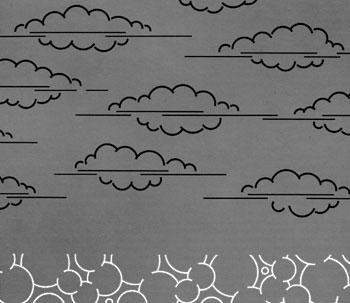Gerard Hemsworth
John Hansard Gallery, Southampton, UK
Art Monthly, Issue 223, February 1999

Image: Gerard Hemsworth, Weekender
It is a very difficult colour to grasp. It is not quite grey, but to call it anything else would be a mistake. It is not metallic paint, but the colour is only accurately described in terms of metal: a dull gun-metal, dark and ominous. The effect is compounded by that weird matt-shine that you get with perfectly flat acrylic paint. The canvas is large - a little over two metres each way - and landscape in format, but only just. It bears linear images, sunk into the canvas through the careful application and removal of masking tape. The images are sufficiently hard-edged to remind us of a DTP graphics package, very hands-off and non-tactile giving a hard image but an oddly immaterial object. The images themselves are floaty too: evening clouds (or perhaps cartoon rapid-movement dust trails), coupled with bubbles (or perhaps molecular structure diagrams). So not only do the images in this painting represent insubstantial elements, but they are themselves so pared-down that they breed uncertainty and weightlessness. It is a diagram that makes nothing concrete, and would be pure sign if only it signified something. This is Weekender, and the show is 'Strictly Suburban'.
There are 15 paintings and they all share the graphic style of Weekender. Linear images, somewhere between cartoon and diagram, sit in flat, synthetic colour fields. The depictions, if we can call them that and if we can manage to read them, can all be gathered under the umbrella term 'suburban': barbecues, neighbours, garden ponds, soap suds and bubbles, reveries lost in thought. The weather keeps cropping up, too. Always the weather.
Far from being suburban, the painting style is very International High Art. It is highly corporate - more Nat West Tower than Nat West branch - with the kind of studied, forgettable precision that you find in anything that is prefixed by the word 'business'. Business Lounge. Business Class. Business Customers Only. The gallery becomes the lobby of a multinational's headquarters. Or an airport. Such authoritarian styling is intended to make the visitor self-conscious and uptight: every detail is considered, every action prescribed. You must behave because the decor is watching.
But Gerard Hemsworth's paintings are more intriguing than their style would lead us to believe. In fact they give the impression that their style was developed for another reason altogether, but when the artist moved onto more mundane themes he found the style had gained its own inertia. This is what fascinates: the use of a high-powered 80s art fair style in order to talk about nosey neighbours and garden ponds.
Question: What do you call a sheep with no legs? Answer: A cloud. Hemsworth would claim that the old ones are still the best. In Cul-de-Sac a cloud becomes a sheep, its eyes become bubbles. Elsewhere, clouds become thoughts, while circles become snow, become almost anything, then become circles again. So the works slope between figuration and patternation, but to what end? In the accompanying essay, Nick de Ville makes a play on notions of semiotic slippage and the fugitive nature of the sign. This theoretical approach is undoubtedly a correct description of some of the ways in which the work functions, but it is also passe: the essay mentions artists working in the 80s who explored similar areas, and describes the mutability of Hemsworth's images with the phrase 'unstable signs oxidise blandly'. 'Bland' is the right word. Who cares if a cloud becomes a sheep? Blandness might be a useful control for value-free theoretical experiments, but if that was all these works were doing then we would have seen it all before. Fortunately though, and de Ville acknowledges this, these paintings also function on a more prosaic level. It is this collision that gives the works their compelling quality. At a time when we are told that artists are all touchy-feely and domesticated, Hemsworth shows that a supposedly outmoded painting style can be just as uptight about suburbia as it was about Terminal 4.
'Strictly Suburban' is a mix, like most shows, of more and less successful works. The powerful works are those that raise the stakes: that a cloud can be a thought-bubble is not so interesting, but when the imagery suggests real-world consequences things hot up. By coupling artificial colours and distancing graphics with (what might be) chemical structures and clouds, Hemsworth makes acute the anxiety produced by the fugitive sign; failing to grasp a sign can be worrying indeed if we think it is meant to be a warning sign.
Imagine finding an official report written in scientific jargon. You can't quite follow it, but it seems to suggest that polluted rain is carcinogenic. This is the ill-defined sense of horror, the suggestion of an invisible, all-pervasive threat that the best of Hemsworth's paintings carry. While it is the mutability of the signs that suggest safe, suburban values are about as solid as air, it is the choice of sign which suggests the air itself is actively harmful.
— End —